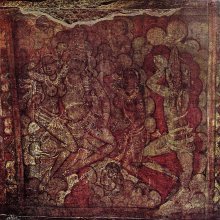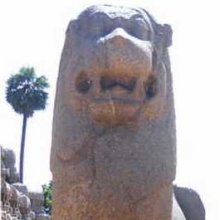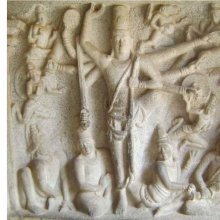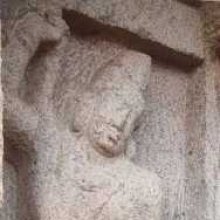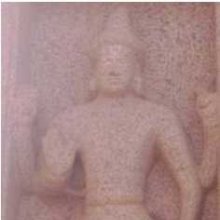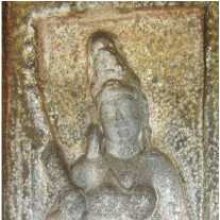Mamallapuram, Māmallapura, Māmallapuram, Mamallapura, Mamalla-pura: 7 definitions
Introduction:
Mamallapuram means something in Hinduism, Sanskrit, the history of ancient India, Tamil. If you want to know the exact meaning, history, etymology or English translation of this term then check out the descriptions on this page. Add your comment or reference to a book if you want to contribute to this summary article.
Images (photo gallery)
(+173 more images available)
In Hinduism
Vastushastra (architecture)
Source: Knowledge Traditions & Practices of India: Architecture (1): Early and Classical ArchitectureMamallapuram or Mahabalipuram.—Rock-cut caves of different parts of India developed variations depending upon the nature of the rock into which they were carved.—Many such cave temples were excavated during the Pallava dynasty of the 7th–8th century in the northern part of Tamil Nadu, especially at Mamallapuram (also known as Mahabalipuram), their port-city in Tamil Nadu.
Examples of Monolithic Temples (shrines carved from top to bottom out of one piece of rock) are seen in Mamallapuram belonging to the 7th century. Famously known as the ‘Five Rathas’ (chariots), these five monolithic monuments are each of a different shape and size and are believed to replicate monuments made of
perishable material that existed prior to their time.

Vastushastra (वास्तुशास्त्र, vāstuśāstra) refers to the ancient Indian science (shastra) of architecture (vastu), dealing with topics such architecture, sculpture, town-building, fort building and various other constructions. Vastu also deals with the philosophy of the architectural relation with the cosmic universe.
Vaishnavism (Vaishava dharma)
Source: Acta Orientalia vol. 74 (2013): Historical sequence of the Vaiṣṇava DivyadeśasMāmallapuram (or Mahābalipurakṣetra, Ardhasetu) refers to Kaṭalmallai, one of the 108 Vaishnava Divya Desam (divyadeśas or divyasthalas), located in the topographical division of Toṇṭaināṭu (“Northern Tamil Nadu”), according to the 9th century Nālāyirativviyappirapantam (shortly Nālāyiram).—Tradition would record the Vaiṣṇava divyadeśas or divyasthalas are 108. The divyadeśa is a base of the cult of Viṣṇu in Viṣṇuism [Vaiṣṇavism] tradition. The list of 108 [viz., Māmallapuram] seems to have reached maturation by about the early 9th century CE as all the deśas are extolled in the hymns of the twelve Āḻvārs.
Source: Acta Orientalia vol. 74 (2013): Historical sequence of the Vaiṣṇava DivyadeśasMāmallapura is another name for Māmallapuram (or Mahābalipurakṣetra, Ardhasetu), which refers to Kaṭalmallai, one of the 108 Vaishnava Divya Desam (divyadeśas or divyasthalas), located in the topographical division of Toṇṭaināṭu (“Northern Tamil Nadu”), according to the 9th century Nālāyirativviyappirapantam (shortly Nālāyiram).—Tradition would record the Vaiṣṇava divyadeśas or divyasthalas are 108. The divyadeśa is a base of the cult of Viṣṇu in Viṣṇuism [Vaiṣṇavism] tradition. The list of 108 [viz., Māmallapura] seems to have reached maturation by about the early 9th century CE as all the deśas are extolled in the hymns of the twelve Āḻvārs.

Vaishnava (वैष्णव, vaiṣṇava) or vaishnavism (vaiṣṇavism) represents a tradition of Hinduism worshipping Vishnu as the supreme Lord. Similar to the Shaktism and Shaivism traditions, Vaishnavism also developed as an individual movement, famous for its exposition of the dashavatara (‘ten avatars of Vishnu’).
Purana and Itihasa (epic history)
Source: Shodhganga: Temples and cult of Sri Rama in TamilnaduMamallapuram (Katalmallai) refers to one of the 108 divyadesas according to Priyavaccan Pillai’s compendium of the Ramayana based on the Nalayirativviyappirapantam.—Katalmallai is the venue of a Temple for Sthalasayana Perumal. It is not clear whether middle cella in the Shore temple Complex, with an image of the Lord carved on a boulder, is the original. Birth place of Bhutattalvar.

The Purana (पुराण, purāṇas) refers to Sanskrit literature preserving ancient India’s vast cultural history, including historical legends, religious ceremonies, various arts and sciences. The eighteen mahapuranas total over 400,000 shlokas (metrical couplets) and date to at least several centuries BCE.
India history and geography
Source: Wikipedia: India HistoryMamallapuram, also known as “Seven Pagodas” or Mahabalipuram, is a town in Chengalpattu district in the southeastern Indian state of Tamil Nadu. It is on the coastline 58 kilometres (36 mi) south of the city of Chennai. Mamallapuram was one of two major port cities by the 7th century within the Pallava kingdom. Along with economic prosperity, it became a center of a group of battle monuments carved out of rock. These are dated to the 7th and 8th centuries: rathas (temples in the form of chariots), mandapas (cave sanctuaries), giant open-air rock reliefs such as the famous Descent of the Ganges, and the Shore Temple dedicated to Shiva, Durga, Vishnu, Krishna and others. The contemporary town plan was established by the British Raj in 1827.
Mamallapuram has 40 ancient monuments and Hindu temples, including Descent of the Ganges or Arjuna's Penance—one of the largest open-air rock relief in the world. Mamallapuram includes several categories of monuments: ratha temples with an architecture of monolith processional chariots built between 630 and 668 CE; the mandapa-viharas with halls and stone roofs with narratives from the Mahabharata, Shaktism and Vaishnavism; rock reliefs particularly bas-reliefs of Shaivism, Shaktism and Vaishnavism; stone cut temples particularly those dedicated to Shiva that also reverentially display Vishnu and others, built between 695 and 722 CE; and, archaeological excavations with inscriptions some dated to 6th century and earlier. The cave temples and monolithic temples were built during the Pallava Period. Mamallapuram is managed by the Archaeological Survey of India.
Source: varalaaru: Airāvati (Jain religious tradition in Tamil Nadu)Mamallapuram popularly called Mahabalipuram is placed in the Indian artistic annals for its magnificent monoliths and rock cut caves with beautiful sculptures both religious and secular that attracts the scholars as well as art historians and the common folk of the world. Some scholars identify this city as Nir peyarru, the famous port referred to in the Perumbanarruppadai, the Sangam age classic.

The history of India traces the identification of countries, villages, towns and other regions of India, as well as mythology, zoology, royal dynasties, rulers, tribes, local festivities and traditions and regional languages. Ancient India enjoyed religious freedom and encourages the path of Dharma, a concept common to Buddhism, Hinduism, and Jainism.
See also (Relevant definitions)
Partial matches: Mamalla, Pura, Puram.
Full-text: Ardhasetu, Katalmallai, Jalacayanam, Mahamallapura, Tiru-katanmallai, Mahabalipura, Mahabalipurakshetra, Tontainatu, Mallai, Itaventai, Trimurti.
Relevant text
Search found 12 books and stories containing Mamallapuram, Māmallapura, Māmallapuram, Mamallapura, Mamalla-pura, Māmalla-puram, Māmalla-pura, Maamallapuram, Mamalla-puram; (plurals include: Mamallapurams, Māmallapuras, Māmallapurams, Mamallapuras, puras, purams, Maamallapurams). You can also click to the full overview containing English textual excerpts. Below are direct links for the most relevant articles:
Vastu-shastra (5): Temple Architecture (by D. N. Shukla)
Temples of Mamallapuram or Mahabalipuram < [Chapter 12 - History of Hindu Temples (Prāsādas and Vimānas)]
Pallava Phase (Circa 600 A.D. to 900) < [Chapter 12 - History of Hindu Temples (Prāsādas and Vimānas)]
Guhārāja Cave-Temples < [Chapter 12 - History of Hindu Temples (Prāsādas and Vimānas)]
Middle Chola Temples (by S. R. Balasubrahmanyam)
Temples in Vikkanampundi < [Vijayalaya]
Amman Shrine < [Tanjavur/Thanjavur (Rajarajesvaram temple)]
The Central Shrine < [Tanjavur/Thanjavur (Rajarajesvaram temple)]
Pallava period (Social and Cultural History) (by S. Krishnamurthy)
Architecture of the Mamalla Style < [Chapter 2 - Origin of Sculptural Art—Its Development and Scheme]
Head-dress of Women (b): Cylindrica cap like Makuta < [Chapter 4 - Material Culture of the People]
Depiction of Birds < [Chapter 4 - Material Culture of the People]
Early Chola Temples (by S. R. Balasubrahmanyam)
Pallava < [Chapter XIII - Prasada: Component Parts]
Bronze, group 2: Age of Aditya I (a.d. 871-907) < [Chapter XI - Sculpture]
Dravidian Art < [Chapter XIV - Conclusion]
The Religion and Philosophy of Tevaram (Thevaram) (by M. A. Dorai Rangaswamy)
Chapter 4.6 - (f) Symbology of Trisula (the trident) < [Volume 2 - Nampi Arurar and Mythology]
Chapter 1.4 - Rishabharudha-murti (depiction of the Brahmani bull) < [Volume 2 - Nampi Arurar and Mythology]
Chapter 1.3 - Umabhaga-murti (depiction of the Mother Goddess) < [Volume 2 - Nampi Arurar and Mythology]
Cosmic Sleep of Vishnu < [April - June 1973]
Somapalle Temple < [July – September, 1981]
Current Topics < [January-February, 1930]
